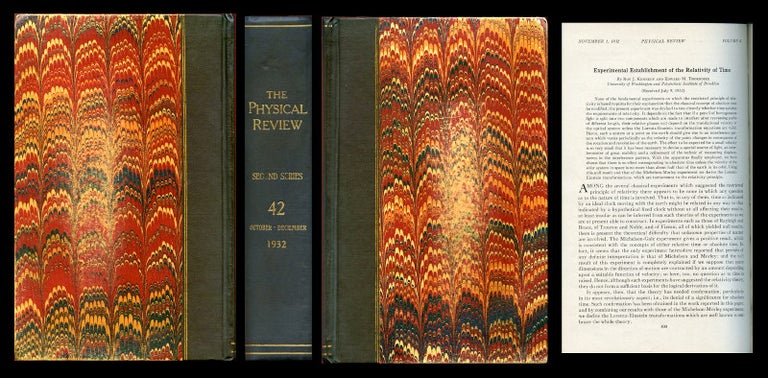Experimental Establishment of the Relativity of Time in Physical Review 42, 1932, pp. 400-418
Lancaster: American Institute of Physics, 1932. 1st Edition. BOUND FIRST EDITION OF AN IMPORTANT EXPERIMENTAL TEST OF THE LORENZ-EINSTEIN TRANSFORMATIONS DESIGNED TO DEMONSTRATE MOTION-INDUCED TIME DILATION. Kennedy and Thorndike “considered the mathematical treatment originally applied to the Michelson-Morley experiment to see if there was a way to.. discriminate between Lorentz ether theory and special relativity” (Marett, Conspiracy of Light, 2012). The primary goal of the authors was “to test the validity of the time dilation effect in the moving frame of the interferometer – as they state, ‘the theory has needed confirmation, particularly in its most revolutionary aspect; i.e., its denial of a significance for absolute time’” (ibid).
“At the time of the Michelson-Morley experiment in 1887, no one was ready for the idea that physics – including the speed of light – is the same in every inertial frame of reference. According to today’s standard Einstein interpretation it seems obvious that both the Michelson-Morley and the Kennedy-Thorndike experiments should give null results. However, when Kennedy and Thorndike made their measurements in 1932, two alternatives to the Einstein theory were open to consideration (designated here as theory A and theory B)” (Wikipedia). “The two theories differed as to the effect of ‘motion through absolute space’ on the running rate of a clock. Theory A said No effect. Theory B said that a standard seconds clock moving through absolute space” would be governed by the Lorentz contraction” (Taylor). Ultimately, the Kennedy Thorndike experiment “ruled out theory A (length contraction alone) but allowed theory B (length contraction plus time contraction)” (ibid)
By far the best description of the intent behind the 1932 experiment of R. J. Kennedy and E. M. Thorndike is present in the abstract to the paper itself: “None of the fundamental experiments on which the restricted principle of relativity is based requires for their explanation that the classical concept of absolute time be modified; the present experiment was devised to test directly whether time satisfies the requirements of relativity.
“It depends on the fact that if a pencil of homogeneous light is split into two components which are made to interfere after traversing paths of different length, their relative phases will depend on the translational velocity of the optical system unless the Lorentz-Einstein transformation equations are valid. Hence, such a system at a point on the earth should give rise to an interference pattern which varies periodically as the velocity of the point changes in consequence of the rotation and revolution of the earth. The effect to be expected for a small velocity is so very small that it has been necessary to devise a special source of light, an interferometer of great stability and a refinement of the technic of measuring displacements in the interference pattern.
“With this apparatus, we have shown that there is no effect corresponding to absolute time unless the velocity of the solar system in space is no more than about half that of the earth in its orbit. Using this null result and that of the Michelson-Morley experiment we derive the Lorentz-Einstein transformations, which are tantamount to the relativity principle” (Kennedy and Thorndike, 1932, 400).
The experiment Kennedy and Thorndike devised was in fact quite similar to the Michelson-Morley experiment, though it differed in two important ways. First, the arms of the interferometer were of differing lengths; second, the apparatus was fixed in a lab and the interference fringes were observed over a period of months – an experiment that highly weighted the demands on the mechanical stability and constancy of the apparatus. “By making one arm of the apparatus much shorter than the other, the rotation of the earth causes differences in the travel times of the light rays between the longer and shorter arms. This would cause a fringe shift to result unless the frequency of the light source also changed to the same degree through relativistic time dilation (which it does). The experiment was conducted over a period of months and no significant fringe shift was found, demonstrating relativistic time dilation” (Wikipedia). Item #759
CONDITION & DETAILS: Lancaster: American Institute of Physics, 8vo. Complete volume. [10], 928, [10]. Ex-libris bearing a small blind (uninked) stamp at the head of the first page (not the Kennedy paper); two small stamps, one on the rear of the title page, one at the foot of the contents page. Handsomely rebound in aged half black cloth over aged marbled paper boards. Gilt-ruled and lettered at the spine. Tightly and very solidly bound. New endpapers. Bright and very clean throughout. Near fine condition.
Price: $475.00

